Traveling to India as an indophile is basically like coming home. That was my experience of India the first time I traveled there in 2011 and even more so this time. It was like a soothing resting spot on our year long journey, filled with all of the key ingredients that make me an indophile. If you aren’t familiar with the term, indophile pertains to a person who loves India, it’s culture, history, and/or people. Find a out if you too are an indophile at heart.
Here are a few signs of an indophile:
Sign#1: You love the heat of India and I am not just talking about the weather.
Indians love their spice. As you may or may not know, spice means both the amount of chillies used as well as the plethora of other spices that make up the complex delicious favors of each Indian dish. I was predominantly in a state in the south of India called Kerala and I must say it is my favorite Indian cuisine (but I might be a bit biased). Vinay’s family is from Kerala, so both times I traveled there I had the privilege of learning about the local cuisine from Vinay’s mother, Rama, or as I fondly call her, Amma.
The vegetables are served a bit more al dente, they use very little oil and every bit of the coconut is used in all kinds of dishes. Thali is a dish that exists throughout India but what makes up the dish differs from state to state. In Kerala, thali usually consists of a pile of rice surrounded by about six little bowls (or lying right on the banana leave as seen in the photo below), filled with an avial, a toran, sambar, a curry, curd (yogurt) with spices, and payasam (sweet) with a side of papadam (fried chip), plantain chips, and spicy pickled mango/or lime. Can you believe it? So many different complex dishes in one little meal! All of the dishes are pretty healthy. It is just fantastic, oh but it is spicy! Unfortunately, South Indian cuisine is not that easy to find in the states, you are more likely to find North Indian food in most Indian restaurants.
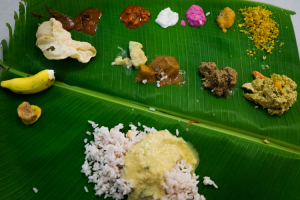
A special thali plate that is served at traditional South Indian celebrations, like the festival of Onum and weddings.
Sign #2: Bollywood films, music and dancing make you so happy you will just burst out into song and dance.
While in Bombay and Trivandrum this visit, I had a craving for a good Bollywood flick. I was so hungry for one that I didn’t mind that the three hour action packed film complete with song and dance was in Hindi without English subtitles. And let me tell you, I didn’t even need them, I was so happy, I was the only one in the theater breaking out in dance anytime the actors would. Have you ever seen a Bollywood film? If you haven’t, you should. Here are some of my favorites to get you started: “Lunch Box”, “Monsoon Wedding”, “Three Idiots”, and “Lagaan”, to name a few. Even though it did not start out this way, the current Bollywood film is filled with a bouquet of song and dance like a musical, it is also known as a “marsala film”. The exotic and colorful settings, along with the emotions evoked in these films, makes me feel alive. So when I was in India, I had to get my fill even if I didn’t understand all of the dialogue. I still got up and danced to the film “Bang Bang”. It had everything you ever dreamed of in a Bollywood flick; singing, dancing, action, family drama, revenge and even a bit of love. No subtitles required for this indophile.
Sign#3: You can’t leave home without bangles as your accessory to every outfit (even western wear).
India is one of the countries where it is recommended to wear the local clothing as a woman unless you want to get stares from every direction. For me, It is one of my favorite reasons to visit India because I love the bright colors. And wearing the local threads adds to the charm and style of India, in my opinion. Truly you can not wear a sari or Salwar-Kameez without the matching accessories. Even though I don’t necessarily wear these local threads everywhere around the world, one Indian trend I can’t seem to live without are my bangles. You can add color and sparkle to any outfit and they go with everything. It is my inexpensive way to wear my creativity on my sleeve (literally). They are becoming pretty popular throughout the states and they may even help you identify an indophile.
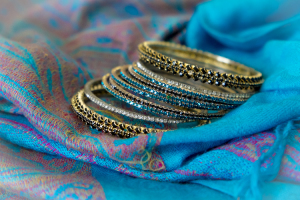
These bangles were given to me by Vinay’s aunt we call Mommi and his brother and sister-in-law Sandeep and Sarita. The only bangles I could take with me for my travels but at least I have them.
Sign #4: You aren’t afraid to use the public toilets in Bombay.
I have even found that some locals would never use these toilets, but when you have to go. . .you know the saying. In yoga, there is a very specific posture that is essential for good kidney and intestinal function, it is also good for releasing the lower back and neck muscles. It is known as the “squat”. This is different then doing squats in body building or western workouts. This position is where you sit all the way down, almost to the ground, your knees nestle up into your armpits. It is a fantastic posture for general health and well-being and it is essential to use the loo in India. Basically a hole in the ground that has a place for your feet on either side of the hole. If you can conquer this act, you can officially call yourself an “indophile”.
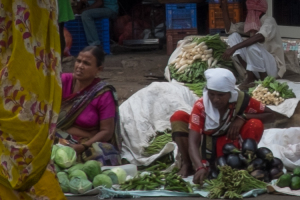
On the streets of Bombay, you can see the vendors even sitting in a comfortable squat as they sell there goods.
Sign #5: You prefer to eat with your hands.
South Indian culture, more than the north, typically eats with their hands, correction, only your right hand (for reasons better shared in person). Even though in India, they will typically offer westerners the option of silverware, if you prefer to eat with your hand you may be considered an indophile.
As you can see I am clearly an indophile myself and with this article I hope to give you full permission to embrace your inner indophile. There are plenty of other reasons to love India’s culture, history and people as I do. Feel free to share your favorites with me in the comments below.
In this post I’d like to tell you a bit about the interesting coffee culture of Croatia, and what to do if you’re a tourist without a ready kitchen while in Croatia (hint, it’s not good!)
My morning breakfast is usually a Coffee and a Pastry (In retrospect, as I write this blog 3 months later, that breakfast was primarily responsible for about 15 pounds of weight gain. Kids, don’t try this at home. Or anywhere else for that matter!). While in most places (Well, most places in Eurameritralia at least) this can be accomplished simply by going to a Café and ordering one of each, in Croatia, this requires visiting first a Pastry Shop to get the Pastry, and then a Café to get the Coffee. Talk about singular focus on core competence!
It comes down as follows. Croatia has a culture of ‘Caffe Bars’, which are exactly what they say: A Café and a Bar. They serve all sorts of espresso drinks and juices, that you get in a café, and all sorts of Bar drinks, such as soft drinks and Alcohol. Cafes seem central to Croatian hanging out culture. Come weekday or weekend, rain or shine, there are almost always tons of people hanging out in the myriad cafes in the myraid-er alleyways in Zagreb. If you were in August, you would probably have found me there as well.

Blogging Away at Express, one of the two best Cafes in Zagreb
What they don’t serve is any sort of pastries, sandwiches or any solid food at all. So unlike cafes elsewhere, where you could get a coffee and a pastry or a sandwich (or a Chatpata Paratha Wrap if you are in India!), here you bring your own food and have it with your coffee. This is made convenient by neighboring establishments called ‘Pekaras’ or ‘Pekarnicas’ (Bakeries) where they sell only Pastries and Sandwiches.
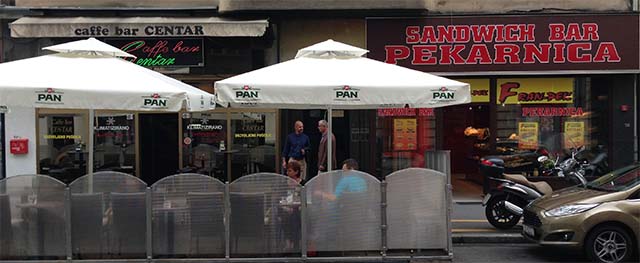
Typical example. A Caffe where you get just the coffee, with a neighboring bakery, where you get just breads!
I couldn’t figure out what resulted in this kind of a system. Talk about focusing on your core competence and outsourcing everything else!
The other unusual part of Caffes is that they only do Espresso. There is no concept of Drip Coffee.
If you ever find yourself in a Croatian Caffe Bar looking incredulously at the menu, here is a tiny guide to help you:
I soon realized that to get what I considered a Cappuccino, I needed to order the Kava s Mlijekom.
After a week, I was really excited upon finding the 2 places in Zagreb that actually do a Cappuccino the way I’m used to – complete with micro foam and artwork! Express Cafe Bar and Elis Caffe. These 2 cafes have Baristas that partake in the Barista competitions and know their coffee. Also, Croatia is blessed with good milk, so the Cappuccino in these places are really good.
Now that we talked about my favorite subject of coffee, let’s come to the topic of food in Zagreb (and indeed, in many towns in Croatia).
I have to start by saying that I love the country of Croatia. It has a rich history, beautiful cities, an amazing coastline, and an honest and hardworking people. The food here, unfortunately, was the most disappointing bit of our entire stay in this country.
This would be my take on how you would create the cuisine if you were the God responsible for the creation of Croatia. You take middling Italian food, blend in some middling Greek food, and throw in a pile of grilled meat, and you pretty much have it.
Most Croatian restaurant food can be summed up in 3 words, and this restaurant did so very aptly:
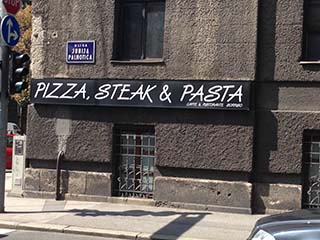
The name is the menu. Efficiency!
That was pretty much the fanfare at any Croatian restaurant we went to. The main difference between the menus of different Croatian restaurants is the paper that it is printed on.
They all have the same set of the following:
Čevapi is a grilled meat dish which is essentially a Smorgasbord of different meats, with some potato fries on the side and the odd tomato added for garnishing.
Now the list probably looks like a decent amount of variety. But just try the same menu everyday for 3 weeks, and you’ll soon be resorting to hunting around grocery stores and the like. Speaking of grocery stores, I found the very best flavored yoghurt in Croatia. It’s Pista&Almond flavored yoghurt with real Pistachios in it! We spent many an afternoon feasting on just this!
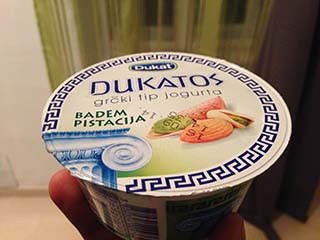
Yes I know it’s greek. I don’t care. It was awesome!
Now I ended up spending 6 weeks in Croatia finishing up my Physical Therapy. As you might guess, the last couple weeks were spent searching high and low for any place that served non-Croatian food. In Zagreb I finally found a few and was happy. In the small touristy coastal towns, unfortunately, unless you’re willing to take a car and go hunting outside the coastal towns for food, you’re pretty much stuck with same ol’ Pizza Pasta etc… I had to make up for the lack of flavor with the view. And make up it did. The Coastal towns are some of the most beautiful towns I have seen in my life…
Now I’m sure that in every town, if you go outside the main areas you might find more variety, and the locals know these places. But as a traveler, you spend most time around the center of most towns, and this was unfortunately the only options we had there…
If you do end up going to Zagreb, these are a few of my picks to get a respite from Croatian Pizza Pasta Čevapi:
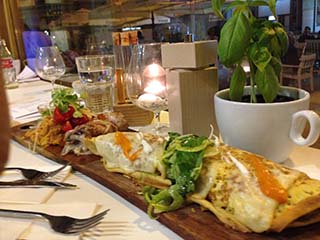
Mundoaka Magic!
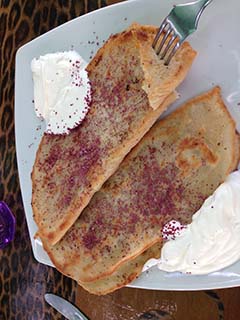
To be fair, we did get excellent, tasty, Croatian food one evening. It required taking a taxi out of the town center to probably the parts where the locals camp out! The place was called Stari Puntijar. It was in a hotel that was converted from a castle, and is worth going there just for the décor! I hear it’s used by the Government officials for their formal dinners. If you want to sample Croatian food that’s not the staple tourist fare, go there.
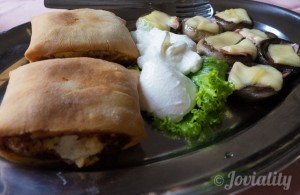
Struklji Roasted & Stuffed Mushrooms
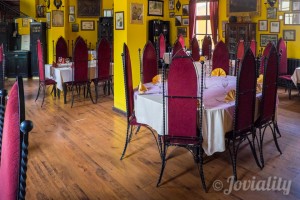
Fit for a King!

Apparently the owner likes to don this and go partake in Medeival fairs!
In my hometown of Kerala, we have a sizeable population of Christians. Among the many fun things they do (like fruit cake infused with rum!) is making homemade wine. Kerala wine is made from grapes (usually) and during festivals (usually). It is a light red in color, has a tingly sweet taste, and is served chilled.
Growing up in Kerala, this tasty sweet nectar was what I came to know and relish as wine. Hence imagine my surprise when, upon arriving in California, I see the people there losing their pants over this bitter dark red liquid that they called wine. Not only did it not sit well on my tongue, but it also came with names pronounced nothing like they were spelled. If you are from Kerala, and reading this, let me give you a few examples:
One of the popular bitter red liquids is spelled Pinot Noir, but they say ‘Pee-No Nuah’. Then you have Cabernet Sauvignon pronounced ‘Kya-Burr-Nay Saw-vee-nyon’. Don’t even get me started on Gewurztraminer.
As if that isn’t enough, you have people with real jobs and decent IQ scores spending hours debating and arguing over which region in some faraway village in France or Chile had the right temperate climate for growing grapes with the right amount of ‘tannins’ (something that made the wine more bitter. Why would you even want to do that?!). It’s not uncommon in yet another overpriced and underlit wine bar in San Francisco to hear a heated debate like, “Yes perhaps the Rio Negro region in central Argentina has 72% humidity, right for Malbec grapes, but in the Bordeaux valley behind my uncle’s house there is a 1 square meter area where his poodle used to pee that has soil with just the right concentration of nitrates to grow grapes suited for Vintage Merlot”. All this energy expended for fermented grape juice that someone forgot to add sugar to.
Now that I got that off my chest, back to Kerala Wine. Last week I was in Porto, Portugal, which is known for Port wine. In fact, just like you cannot call sparkling wine Champagne unless it is grown in the Champagne region in France, you cannot call sweet wine Port, unless, you guessed it, it is grown in the Porto district.
Porto is a beautiful city with lots of hilly roads similar to San Francisco & Thiruvananthapuram, and insanely high bridges like this one:
I came to Porto to join my friend Rodrigo and a bunch of his pals to spend a guys’ weekend doing guy things like imitating the Reservoir Dogs
and wine tasting
There are 4 main types of Port wine: White, Rose, Red, and Tawny. Then you have a couple fancy ones like Colheita & Vintage. I have had Port wine back in the US, and it was always the Red category. I didn’t know the other kinds existed till my visit here. I first tasted the white and red, and it was good. Sweet fruity all round goodness.
Then I tried the Rose Port. With the first sip, memories of Christmas in Kerala came flooding back. Suddenly, like a game of Nostalgia Tetris, it all fell into place!
I’m extrapolating here, so the rest is just theory pieced together from talking to local Portuguese folks and Wikipedia, so bear with me for any historical inaccuracies:
Kerala Christians came about as a result of conversion to Christianity by Portuguese missionaries who arrived after the first Portuguese explorer, Vasco Da Gama. Hence it would totally make sense that the wine that they brought would also be what continues to be made in Kerala. (Edit: From my friend Praveen, a bonafide Kerala Christian: Christianity came to Kerala in 52 AD brought in by St Thomas, a Jew. Not by the Portugese who converted or tried to convert existing Syrian Christians into Catholicism . Also, wines existed in Kerala much before the Portuguese came. They were made by the jews and were fairly sweet. So it would seem that while the mystery did get solved for me, the wines have nothing to do with the Port wines in Portugal after all…)
One interesting bit of info was that till recently the only Port wines sold in Portugal were White, Red and Tawny. The Rose wines started to be sold only a few years ago. So our wine guide was a bit puzzled when I told him we had Rose port equalents for a couple centuries at least in Kerala. Then he told me how that possibly could have happened. To make Red Port, the grapes are first crushed, and then filtered to remove the pulp and skins. After that, the skins are re-introduced into the liquid for the wine to get it’s dark rich color. For this the skin needs to be separated from the pulp and then re-introduced. If that process is skipped, what you get is Rose wine. So years ago, it’s quite possible that the technique of reintroducing the skins was not practiced. Also, the wine needed to sit in the casks for quite a few months for the color to spread. Rose wine (& Kerala wine) is only fermented for 2 weeks maximum before it is bottled and drank.
So there you have it. Portuguese Port wine in a certain form still being made in Kerala! A couple points still nag at me though. Namely:
If any of you readers have an idea, please let the rest of us know in the comments below.
